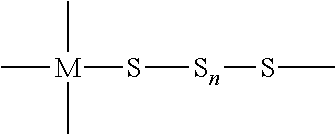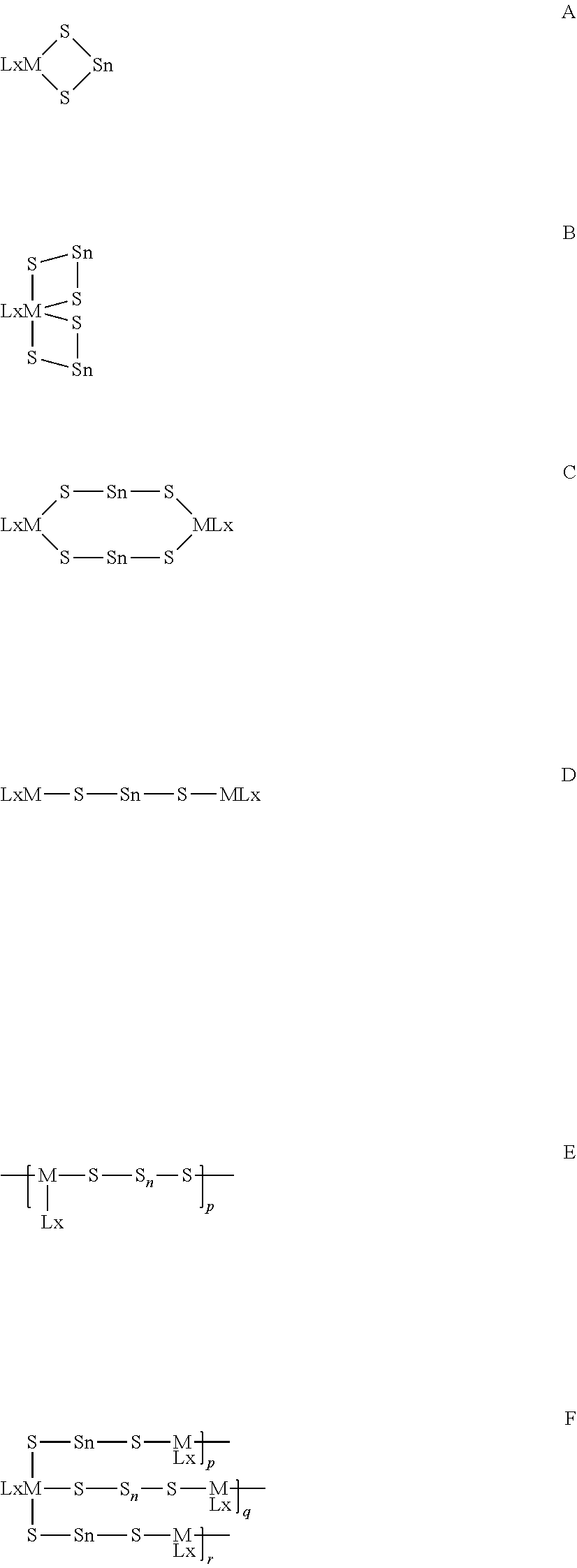Method for the manufacture of cyclododecasulfur
a technology of cyclododecasulfur and allotrope, which is applied in the field of cyclododecasulfur, can solve the problems of multiple convoluted manufacturing steps, low yield, and methods for manufacturing cyclic sulfur allotropes
- Summary
- Abstract
- Description
- Claims
- Application Information
AI Technical Summary
Benefits of technology
Problems solved by technology
Method used
Image
Examples
example 2
Chloride as Solvent for Metallasulfur Derivative and Dispersant for the Oxidizing Agent
[0131]To a 2 L round bottom flask equipped with a stir bar, nitrogen purge and cold water condenser, was added 900 mL of methylene chloride. The flask was cooled in an ice bath. About 25 mL of methylene chloride was added to a separate glass bottle and 18.29 g of bromine weighed into the same bottle and this combination was added to the round bottom flask and washed down with 25 mL of methylene chloride. Then 45.17 grams of (TMEDA)Zn(S6) complex, (94% purity by NMR, prepared according to the method of Example 1) was added to the flask and washed down with 50 mL of methylene chloride. The reaction was stirred for 15 minutes and then filtered using a Buchner funnel and 1 micron filter paper. The solids were then transferred to a second round bottom flask and slurried with 400 mL of THF. This slurry was stirred for 30 minutes and then filtered using a Buchner funnel and 1 micron filter paper. The res...
example 3
zene as Solvent for Metallasulfur Derivative and Dispersant for Oxidizing Agent
[0132]To a 1 L round bottom flask equipped with a stir bar, nitrogen purge and cold water condenser, was added 400 mL of chlorobenzene. The flask was cooled in an ice bath. About 25 mL of chlorobenzene was added to a separate glass bottle and 8.06 grams of bromine weighed into the same bottle. This was added to the round bottom flask and washed down with 25 mL of chlorobenzene. Then 20 grams of (TMEDA)Zn(S6) complex, (94% purity by NMR, from the same batch as Example 1) was added to the flask and washed down with 50 mL of chlorobenzene. The reaction was stirred for 15 minutes and then filtered using a Buchner funnel and 1 micron filter paper. The solids were then transferred to a second round bottom flask and slurried with 200 mL of THF. This slurry was stirred for 30 minutes and then filtered using a Buchner funnel and 1 micron filter paper. The resulting solids were then transferred to yet another round...
example 4
as Solvent for Metallasulfur Derivative and Dispersant for Oxidizing Agent
[0133]To a 1 L round bottom flask equipped with a stir bar, nitrogen purge and cold water condenser, was added 450 mL of p-xylene. The flask was cooled in an ice bath. Then 20 grams of (TMEDA)Zn(S6) complex, (94% purity by NMR, from the same batch as Example 1). 8.06 grams of bromine were weighed into a small vial and transferred to an addition funnel. Bromine was added slowly to the round bottom flask over 15 minutes. After bromine addition, the reaction was stirred for an additional 15 minutes and then filtered using a Buchner funnel and 1 micron filter paper. The solids were then transferred to a second round bottom flask and slurried with 200 mL of THF. This slurry was stirred for 30 minutes and then filtered using a Buchner funnel and 1 micron filter paper. The resulting solids were then transferred to yet another round bottom flask and cooled in an ice bath. 75 mL of ice-cooled CS2 was added to the third...
PUM
 Login to View More
Login to View More Abstract
Description
Claims
Application Information
 Login to View More
Login to View More - R&D
- Intellectual Property
- Life Sciences
- Materials
- Tech Scout
- Unparalleled Data Quality
- Higher Quality Content
- 60% Fewer Hallucinations
Browse by: Latest US Patents, China's latest patents, Technical Efficacy Thesaurus, Application Domain, Technology Topic, Popular Technical Reports.
© 2025 PatSnap. All rights reserved.Legal|Privacy policy|Modern Slavery Act Transparency Statement|Sitemap|About US| Contact US: help@patsnap.com



